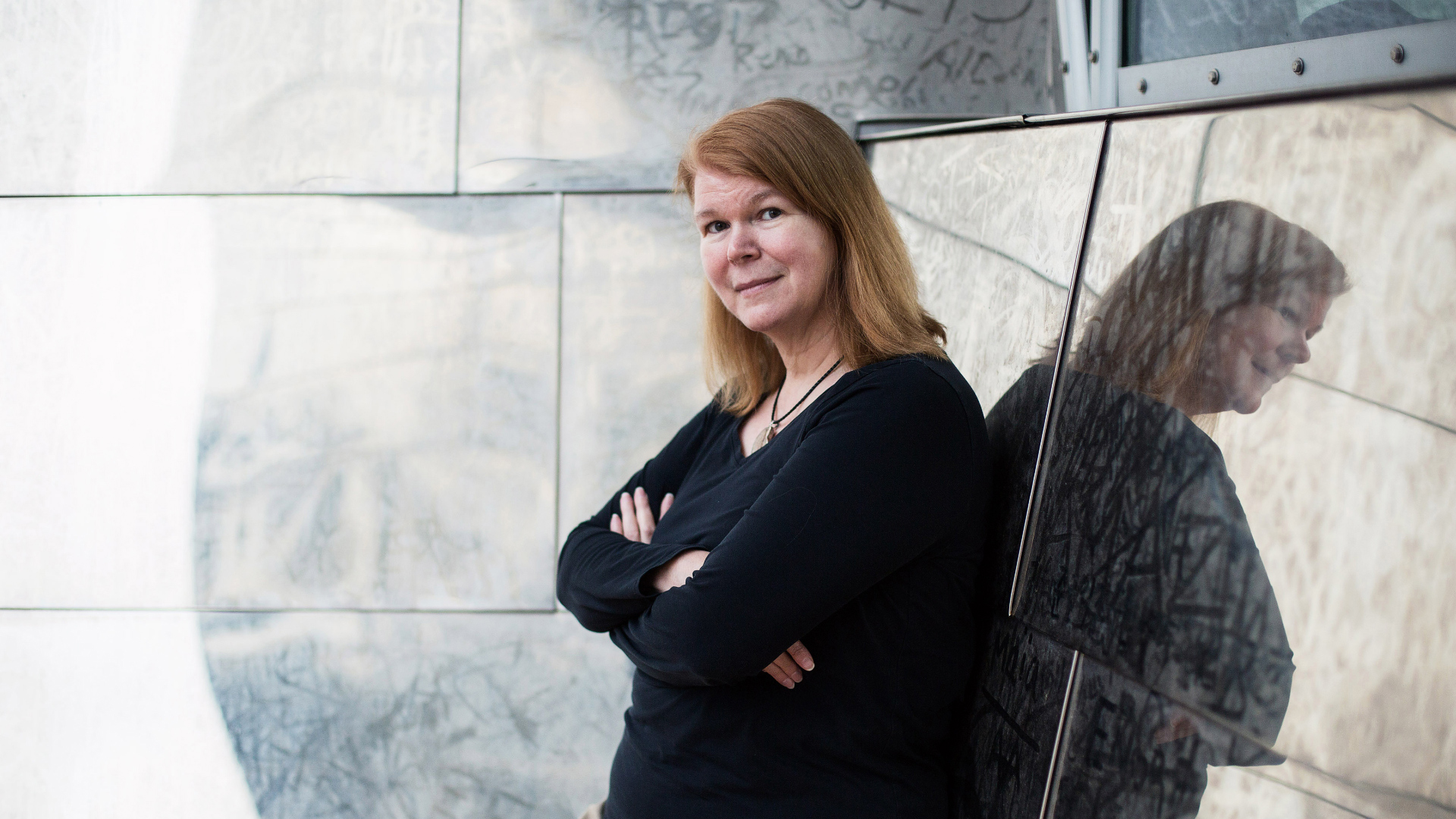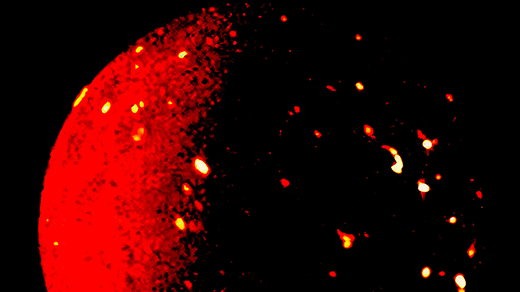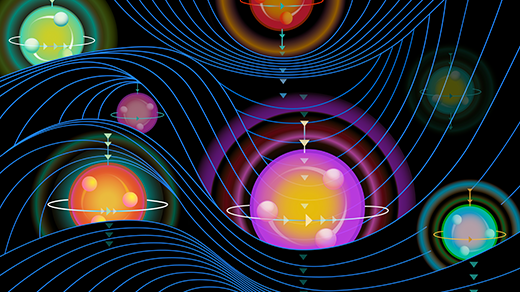On a Hunt for a Ghost of a Particle

Even for a particle physicist, Janet Conrad thinks small. Early in her career, when her peers were fanning out in search of the top quark, now known to be the heaviest elementary particle, she broke ranks to seek out the neutrino, the lightest.
In part, she did this to avoid working as part of a large collaboration, demonstrating an independent streak shared by the particles she studies. Neutrinos eschew the strong and electromagnetic forces, maintaining only the most tenuous of ties to the rest of the universe through the weak force and gravity. This aloofness makes neutrinos hard to study, but it also allows them to serve as potential indicators of forces or particles entirely new to physics, according to Conrad, a professor at the Massachusetts Institute of Technology. “If there’s a force out there we haven’t seen, it must be because it is very, very weak — very quiet. So looking at a place where things are only whispering is a good idea.”
In fact, neutrinos have already hinted at the existence of a new type of whispery particle. Neutrinos come in three flavors, morphing from one flavor to another by means of some quantum jujitsu. In 1995, the Liquid Scintillator Neutrino Detector (LSND) at Los Alamos National Laboratory suggested that these oscillations involve more than the three flavors “we knew and loved,” Conrad said. Could there be another, more elusive type of “sterile” neutrino that can’t feel even the weak force? Conrad has been trying to find out ever since, and she expects to get the latest result from a long-running follow-up experiment called MiniBooNE within a year.
Still, even MiniBooNE is unlikely to settle the question, especially since a number of other experiments have found no signs of sterile neutrinos. So Conrad is designing what she hopes will be a decisive test using — naturally — a small particle accelerator called a cyclotron rather than a behemoth like the Large Hadron Collider in Europe. “I feel like my field just keeps deciding to get at our problems by growing, and I think that there’s going to be a point at which that’s not sustainable,” Conrad said. “When the great meteor hits, I want to be a small, fuzzy mammal. That’s my plan: small, fuzzy mammal.”
Quanta Magazine spoke with Conrad about her hunt for sterile neutrinos, her penchant for anthropomorphizing particles, and her work on the latest Ghostbusters reboot. An edited and condensed version of the interview follows.
QUANTA MAGAZINE: What would it mean for physics if sterile neutrinos exist?
JANET CONRAD: The Standard Model of particle physics has done very well in predicting what’s going on, but there’s a great deal it can’t explain — for example, dark matter. Right now we’re desperately looking for clues as to what the larger theory would be. We have been working on ideas, and in many of these “grand unified theories,” you actually get sterile neutrinos falling out of the theory. If we were to discover that there were these extra neutrinos, it would be huge. It would really be a major clue to what the larger theory would be.
You’ve been looking for neutrinos your entire career. Was that always the plan?
I started out thinking I was going to be an astronomer. I went to Swarthmore College and discovered that astronomy is cold and dark. I was lucky enough to get hired to work in a particle physics lab. I worked for the Harvard Cyclotron, which was at that time treating eye cancers. But in the evenings physicists would bring their detectors down and calibrate them using the same accelerator. I was really interested in what they were doing and got a position the next summer at Fermilab. It was such a good fit for me. I just think the idea of creating these tiny little universes is so wondrous. Every collision is a little world. And the detectors are really big and fun to work on — I like to climb around stuff. I liked the juxtaposition of the scales; this incredibly tiny little world you create and this enormous detector you see it in.
And how did you get into neutrino research in particular?
When I was in grad school, the big question was: What is the mass of the top quark? Everybody expected me to join one of the collider experiments to find the top quark and measure its mass, and instead I was looking around and was quite interested in what was going on in the neutrino world. I actually had some senior people tell me it would be the end of my career.
Why did you take that risk?
I was very interested in the questions that were coming out of the neutrino experiments, and also I didn’t really want to join an enormously large collaboration. I was more interested in the funny little anomalies that were already showing up in the neutrino world than I was in a particle which had to exist — the top quark — and the question of what was its precise mass. I am really, I suppose, an anomaly chaser. I admit it. Some people might call it an epithet. I wear it with pride.
One of those anomalies was the hint of an extra type of neutrino beyond the three known flavors in the Standard Model. That result from LSND was such an outlier that some physicists suggested dismissing it. Instead, you helped lead an experiment at Fermilab, called MiniBooNE, to follow up on it. Why?
You’re not allowed to throw out data, I’m sorry. That is exactly how to miss important new physics. We can’t be so in love with our Standard Model that we aren’t willing to question it. Even if the question doesn’t align with our prejudices, we have to ask the question anyway. When I started out, nobody was really interested in sterile neutrinos. It was a lonely land out there.
MiniBooNE’s results have added to the mystery. In one set of experiments using antineutrinos, it found LSND-like hints of sterile neutrinos, and in another, using neutrinos, it did not.
The antineutrino result matched up with LSND very well, but the neutrino result, which is the one we produced first, is the one that doesn’t match up. The whole world would be a very different place if we had started with antineutrino running and gotten a result that matched LSND. I think there would have been a lot more interest immediately in the sterile-neutrino question. We would have been where we are now at least 10 years earlier.
Where are we now?
There are eight experiments total that have anomalies suggesting the presence of more than the three known flavors of neutrino. There are also seven experiments that don’t. Recently, some of the experiments that have not seen an effect have gotten a lot of press, including IceCube, which is a result that my group worked on. A lot of press came out about how IceCube didn’t see a sterile-neutrino signal. But while the data rules out some of the possible sterile-neutrino masses, it doesn’t rule out all of them, a result we point out in an article that has just been published in Physical Review Letters.
Why are neutrino studies so hard?
Most neutrino experiments need very large detectors that need to be underground, almost always under mountains, to be protected from cosmic rays that themselves produce neutrinos. And all of the accelerator systems we build tend to be in plains — like Fermilab is in Illinois. So once you decide you’re going to build a beam and shoot it for such a long distance, the costs are enormous, and the beams are very difficult to design and produce.
Is there any way around these problems?
What I would really like to see is a future series of experiments that are really decisive. One possibility for this is IsoDAR, which is part of a larger experiment called DAEδALUS. IsoDAR will take a small cyclotron and use it as a driver to produce lithium-8 that decays, resulting in a very pure source of antielectron neutrinos. If we paired that with the KamLAND detector in Japan, then you would be able to see the whole neutrino oscillation. You don’t just measure an effect at a few points, you can trace the entire oscillation wave. The National Science Foundation has given us a little over $1 million to demonstrate the system can work. We’re excited about that.
Why would IsoDAR be a more decisive sterile-neutrino hunter?
This is a case where you don’t produce a beam in the normal way, by smashing protons into a target and using a series of magnetic fields to herd the resulting charged particles into a wide beam where they decay into several kinds of neutrinos, among other particles. Instead you allow the particle you produce, which has a short lifetime, to decay. And it decays uniformly into one kind of neutrino in all directions. All of the aspects of this neutrino beam — the flavor, the intensity, the energies — are driven by the interaction that’s involved in the decay, not by anything that human beings do. Human beings cannot screw up this beam! It’s really a new way of thinking and a new kind of source for the neutrino community that I think can become very widely used once we prove the first one.
Kayana Szymczak for Quanta Magazine
Video: Conrad explains how sterile neutrinos might help physicists move past the Standard Model.
So the resulting neutrino interactions are easier to interpret?
We’re talking about a signal-to-background ratio of 10 to one. By contrast, most of the reactor experiments looking for antineutrinos are running with a signal-to-background ratio of one to one if they do well, since the neutrons that come out of the reactor core can actually produce a signal that looks a lot like the antineutrino signal you are looking for.
Speaking of spectral signals, tell me about your connection with the recent Ghostbusters movie remake.
It’s the first movie I’ve consulted for. It happened because of Lindley Winslow. She was at the University of California, Los Angeles, before she came to MIT. At UCLA, she had made a certain amount of connection with the film industry, and so they had gotten in touch with her. She showed them my office, and they really liked my books. My books are stars — you do get to see them in the movie and some of the other things from my office here and there. When they brought the books back, they put them all back exactly the way they were. What’s really funny about that was that they were not in any order.
What did you think of the movie itself? Did you relate to the way Kristen Wiig played a physicist?
I was really happy to see a whole new rendering of it. To watch the characters interact; I think there was a lot of impromptu work. It really came through that these women resonated with each other. In the movie, Kristen Wiig goes into an empty auditorium and she rehearses for her lecture. I felt for that character. When I started out as a faculty member, I had very little experience as somebody who actually taught — I had done all this research. It’s kind of ridiculous to think about now, but I went through those first lectures and really rehearsed them.
In a way, your career has come full circle, since you started out working at a cyclotron in college and now you want to use another one to hunt for sterile neutrinos. Can you really do cutting-edge research with cyclotrons that accelerate particles to energies just a thousandth of a percent of those reached at the Large Hadron Collider?
Cyclotrons were invented back at the beginning of the last century. They were limited in energy, and as a result, they went out of fashion as particle physicists decided that they needed larger and larger accelerators going up to higher and higher energies. But in the meantime, the research that was done for the nuclear physics community and also for medical isotopes and for treating people with cancer took cyclotrons in a whole different direction. They’ve turned into these amazing machines, which now we can bring back to particle physics. There are questions that can perhaps be better answered if you are working at lower energies but with much purer beams, with more intense beams, and with much better-understood beams. And they’re really nice because they’re small. You can bring your cyclotron to your ultra-large detector, whereas it’s very hard to move Fermilab to your ultra-large detector.
A single type of sterile neutrino is hard to reconcile with existing experiments, right?
I think the little beast looks different from what we thought. The very simplistic model introduces only one sterile neutrino. That would be a little weird if you were guided by patterns. If you look at the patterns of all the other particles, they’re appearing in sets of three. If you introduce three, and you do all the dynamics between them properly, does that fix the problem? People have taken a few steps toward answering that, but we’re still doing approximations.
You just called the sterile neutrino a “little beast.” Do you anthropomorphize particles?
There’s no question about that. They all have these great little personalities. The quarks are the mean girls. They’re stuck in their little cliques and they won’t come out. The electron is the girl next door. She’s the one you can always depend on to be your friend — you plug in and there she is, right? And she’s much more interesting than people would think. What I like about the neutrinos is they’re very independent. With that said, with neutrinos as friends, you will never be lonely, because there are a billion neutrinos in every cubic meter of space. I have opinions about all of them.
When did you start creating these characterizations?
I’ve always thought about them that way. I have in fact been criticized for thinking about them that way and I don’t care. I don’t know how you think about things that are disconnected from your own experience. You have to be really careful not to go down a route that you shouldn’t go down, but it’s a way of thinking about things that’s completely legitimate and gives you some context. I still remember once describing some of the work I was doing as fun. I had one physicist say to me, “This is not fun; this is serious research.” I was, like, you know, serious research can be a lot of fun. Being fun doesn’t make it less important — those are not mutually exclusive.
This article was reprinted on Wired.com.



